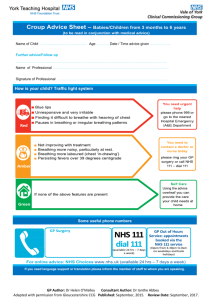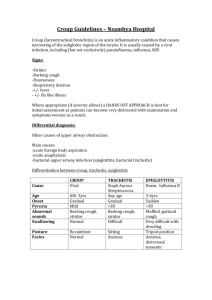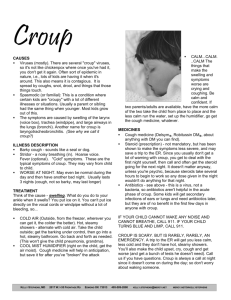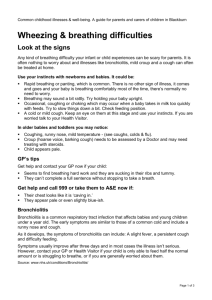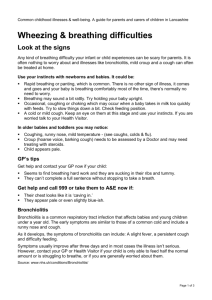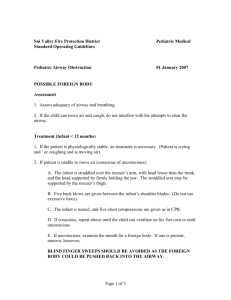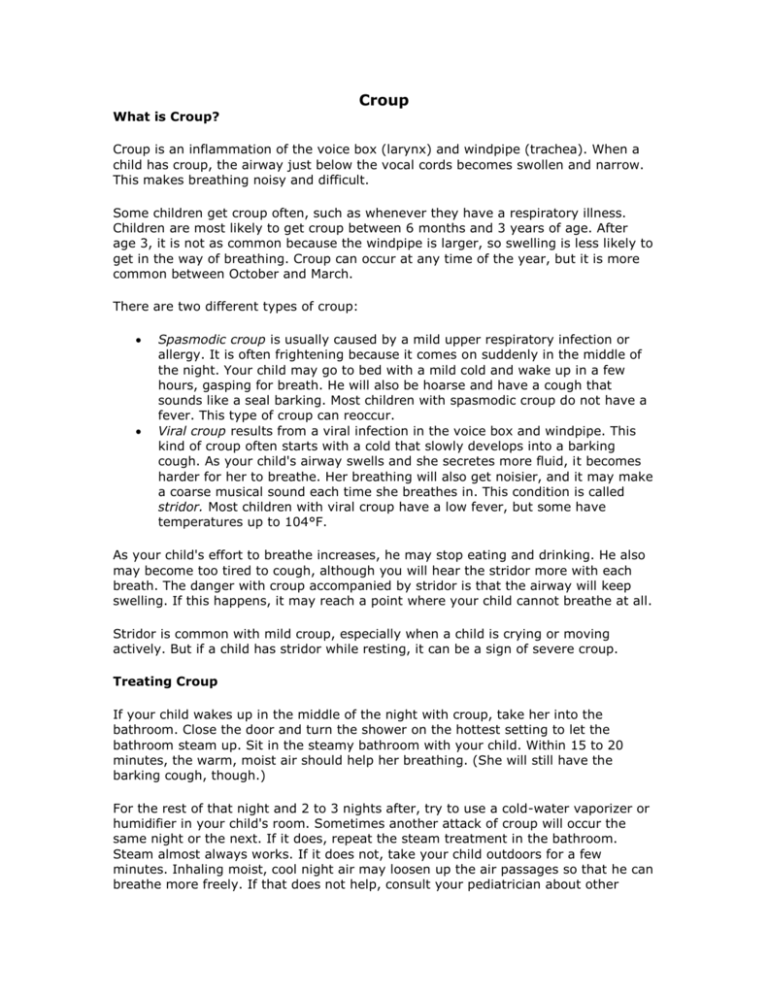
Croup
What is Croup?
Croup is an inflammation of the voice box (larynx) and windpipe (trachea). When a
child has croup, the airway just below the vocal cords becomes swollen and narrow.
This makes breathing noisy and difficult.
Some children get croup often, such as whenever they have a respiratory illness.
Children are most likely to get croup between 6 months and 3 years of age. After
age 3, it is not as common because the windpipe is larger, so swelling is less likely to
get in the way of breathing. Croup can occur at any time of the year, but it is more
common between October and March.
There are two different types of croup:
Spasmodic croup is usually caused by a mild upper respiratory infection or
allergy. It is often frightening because it comes on suddenly in the middle of
the night. Your child may go to bed with a mild cold and wake up in a few
hours, gasping for breath. He will also be hoarse and have a cough that
sounds like a seal barking. Most children with spasmodic croup do not have a
fever. This type of croup can reoccur.
Viral croup results from a viral infection in the voice box and windpipe. This
kind of croup often starts with a cold that slowly develops into a barking
cough. As your child's airway swells and she secretes more fluid, it becomes
harder for her to breathe. Her breathing will also get noisier, and it may make
a coarse musical sound each time she breathes in. This condition is called
stridor. Most children with viral croup have a low fever, but some have
temperatures up to 104°F.
As your child's effort to breathe increases, he may stop eating and drinking. He also
may become too tired to cough, although you will hear the stridor more with each
breath. The danger with croup accompanied by stridor is that the airway will keep
swelling. If this happens, it may reach a point where your child cannot breathe at all.
Stridor is common with mild croup, especially when a child is crying or moving
actively. But if a child has stridor while resting, it can be a sign of severe croup.
Treating Croup
If your child wakes up in the middle of the night with croup, take her into the
bathroom. Close the door and turn the shower on the hottest setting to let the
bathroom steam up. Sit in the steamy bathroom with your child. Within 15 to 20
minutes, the warm, moist air should help her breathing. (She will still have the
barking cough, though.)
For the rest of that night and 2 to 3 nights after, try to use a cold-water vaporizer or
humidifier in your child's room. Sometimes another attack of croup will occur the
same night or the next. If it does, repeat the steam treatment in the bathroom.
Steam almost always works. If it does not, take your child outdoors for a few
minutes. Inhaling moist, cool night air may loosen up the air passages so that he can
breathe more freely. If that does not help, consult your pediatrician about other
options. If your child's breathing becomes a serious struggle, call for
emergency medical services. (In most areas, dial 911.)
Never try to open your child's airway with your finger. Breathing is being blocked by
swollen tissue out of your reach, so you cannot clear it away. Besides, putting your
finger in your child's throat will only upset her. This can make her breathing even
more difficult. For the same reasons, do not force your child to throw up. If she does
happen to vomit, hold her head down and then quickly sit her back up once she is
finished.
Your pediatrician will ask if your child's breathing is better after the steam treatment.
If it is not, your pediatrician may prescribe a steroid medication to reduce swelling in
the throat or shorten the illness. Although it has not been firmly proven that this
works, treatment with a steroid for 5 days or less should do no harm.
Antibiotics, which treat bacteria, are not helpful for croup because the problem is
almost always caused by a virus or allergy. Cough syrups are of little use too,
because they do not affect the larynx or trachea, where the infection is located.
These also may get in the way of your child coughing up the mucus from the
infection.
If you suspect your child has croup, call your pediatrician—even if it is the middle of
the night. Also, listen closely to your child's breathing. Call for emergency medical
services immediately if he:
makes a whistling sound that gets louder with each breath
cannot speak for lack of breath
seems to be struggling to get a breath
seems very pale or has a bluish mouth or fingernails
has stridor when resting
drools or has extreme difficulty swallowing saliva
In the most serious cases, your child will not be getting enough oxygen into her
blood. If this happens, she may need to go into the hospital. There she may be put
in a plastic tent, called a croup tent, to receive oxygen. She may also be fed through
a vein and take medication by inhaling it. Sometimes a tube is inserted through the
nose or mouth into the windpipe to bypass the swelling in the larynx and trachea.
Your child may be hoarse for a while after the tube is removed, but this usually does
not last. Luckily, these severe cases of croup do not occur very often.
© COPYRIGHT AMERICAN ACADEMY OF PEDIATRICS, ALL RIGHTS RESERVED.
American Academy of Pediatrics, 141 Northwest Point Blvd., Elk Grove Village, IL, 60007, 847-434-4000

